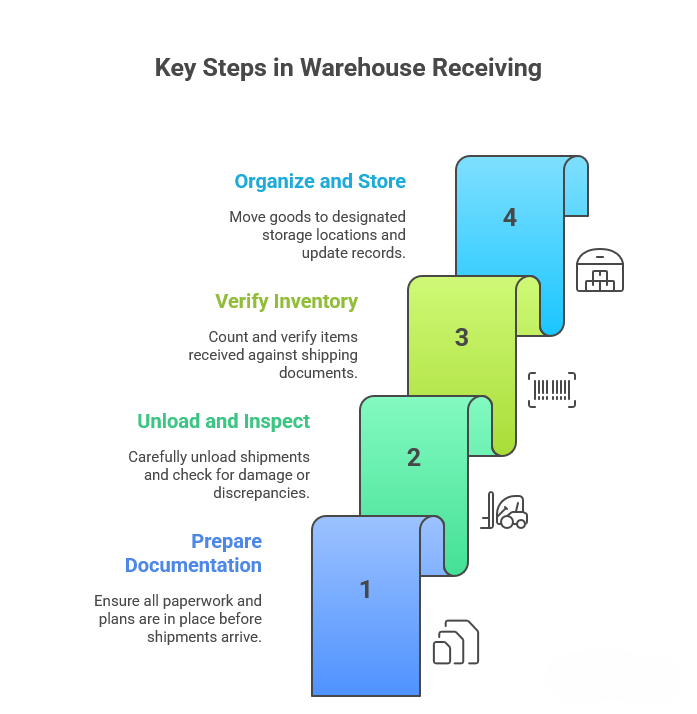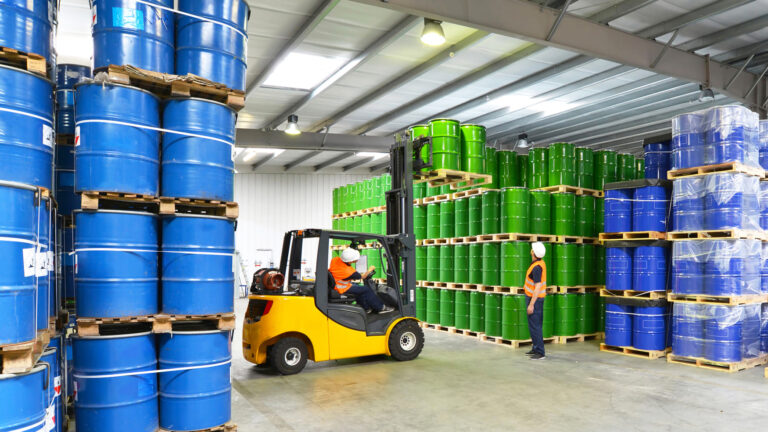Best Practices for Warehouse Receiving Processes

Warehouse receiving is the essential first step of warehouse operations – it encompasses everything from unloading inbound deliveries to updating inventory records. In practice, an effective warehouse receiving process means checking in, inspecting, and storing all incoming goods promptly and accurately. How inventory is received at a warehouse sets the tone for the rest of the supply chain (including picking, packing, and shipping). Mistakes or delays at this stage can ripple through and impact customer satisfaction. In fact, studies show that manual receiving errors can cost warehouses hundreds of thousands of dollars annually. This guide will walk you through the key steps in warehouse receiving and highlight best practices to improve accuracy, speed, and efficiency in your operations.
Key Steps in the Warehouse Receiving Process
1. Prepare Documentation and Plan Shipments: Before any truck arrives, ensure all paperwork and plans are in place. Confirm the purchase orders, advanced shipping notifications, and delivery schedules with your suppliers or carriers. Each incoming shipment should have a clear receiving document (such as a packing list or Warehouse Receiving Order) attached. By establishing a standard warehouse delivery procedure for incoming shipments, you ensure everyone knows what to expect. Proper documentation and planning prevent surprises and allow your team to allocate the right space and equipment ahead of time. For example, if you know a large shipment is coming, you can prep the dock and inform staff in advance (avoiding last-minute scrambles).
2. Unload and Inspect Shipments: When goods arrive at the loading dock, trained staff meet the carrier and carefully unload the truck. Using forklifts or pallet jacks helps move pallets efficiently and safely. Shipments should be unloaded in an order that allows easy access (often back-to-front on the truck). As items are unloaded, warehouse workers visually inspect the cargo for any damage, broken seals, or signs of mishandling. They also verify that the SKUs and quantities match the shipping documents on hand. Catching discrepancies or damage at this stage allows immediate resolution before goods are put away.

3. Verify Inventory Accuracy: After unloading, count and verify the items received. This means matching the delivered quantities and SKUs (product codes) against the documents. Many warehouses use barcode scanners or RFID readers at this stage – as each item or pallet is scanned into the warehouse management system (WMS), the inventory is updated in real time. Leveraging technology in this verification step greatly reduces human error. For example, if a pallet labeled for Item ABC123 actually contains Item XYZ987, a scan will flag the mismatch immediately. Implementing an inventory receiving checklist for staff can be helpful: they should tick off that quantities match, products are correct, and quality is acceptable. By verifying accuracy at receiving, you prevent downstream issues like inventory records not matching what’s actually on the shelf.

4. Organize and Store Inventory: Once everything checks out, move the goods to their designated storage locations in the warehouse. An efficient put-away process is crucial: your WMS or inventory system can suggest optimal storage spots (for example, directing high-turnover items to easily accessible areas). Make sure each pallet, case, or item is labeled and placed in the proper bin, shelf, or zone. All records should be updated to reflect the new stock on hand. Prompt put-away not only clears the receiving area (keeping it uncluttered and ready for the next truck), but also makes the products available for order fulfillment sooner. In a well-organized operation, items might go from dock to stock within hours – meaning they’re ready for picking in the next order cycle. This step closes the loop on receiving: the inventory is now in your system and physically stored in the right place, setting up the rest of your warehouse processes for success.

Warehouse Receiving Best Practices
There are several ways to improve your warehouse receiving process and make it more efficient. Implementing a warehouse receiving process checklist for your team is one way to ensure consistency. Below are key best practices that top warehouses follow:
- Use a Modern Warehouse Management System (WMS): Leverage technology to automate receiving. A robust WMS will allow you to scan inbound shipments and update inventory counts instantly. By integrating your WMS with inventory or ERP software, you get real-time visibility of stock levels as soon as goods arrive. This digital approach eliminates most manual data entry errors and speeds up the receiving workflow. For instance, employees can scan barcodes on each pallet, and the system will automatically log quantities and locations – no clipboards or typing needed. (Implementing a WMS is often the first step to streamlining warehouse receiving.)
- Standardize Procedures and Labeling: Define clear receiving procedures and labeling standards. Every incoming package should follow the same steps. Using standardized barcodes or RFID tags on cartons and pallets makes it much easier to scan and validate shipments. A well-defined labeling structure means staff instantly recognize what an item is and where it should go. Consistency ensures no matter who is on shift, the receiving team follows the same checklist, minimizing mistakes.
- Track Key Metrics: Monitor performance metrics like dock-to-stock cycle time (how long it takes to go from dock arrival to inventory putaway) or receiving accuracy rate. By regularly reviewing these KPIs, warehouses can spot inefficiencies. For instance, tracking how long each shipment spends on the dock can reveal delays. Use built-in reporting tools to keep an eye on inventory metrics across warehouses. Use the data to identify trends (e.g. a particular supplier frequently sends late) and take corrective action.
- Optimize Labor and Scheduling: Efficient staffing is crucial. Use appointment or scheduling systems to even out workload and avoid peak-time backups. For example, assign specific time windows for expected deliveries, so the dock team can prepare in advance. Cross-training staff in both receiving and other warehouse roles adds flexibility. Maintain a pool of trained temporary or float workers for unexpected surges. Proper scheduling and flexibility help ensure the dock is neither overstaffed (wasting labor) nor understaffed (creating delays).
- Conduct Regular Inspections and Audits: In addition to inspecting goods on arrival, schedule periodic spot-check audits of received inventory. Checking items after they are put away (for example, doing cycle counts on received SKUs) can catch errors that slipped through. Regular audits help identify shrinkage or supplier issues before they become big problems. This two-tiered approach – immediate checks plus follow-up audits – keeps inventory records accurate over time.
- Double-Check Documentation: Paperwork errors cause many receiving headaches. Always verify that the items received match the purchase order, bill of lading, and packing list. Implement a systematic way to handle documents – for example, use sequentially numbered forms and require signatures on each receiving report. Every type of receiving or shipping document follow a numbering system so staff can easily spot missing papers. In practice, training staff to cross-reference quantities and SKUs on every document prevents simple mistakes.
- Train Staff and Ensure Safety: Ongoing training is vital. Make sure every team member knows the proper receiving procedures and safety protocols. For example, teach the correct way to operate forklifts and pallet jacks to avoid product damage. Keep the receiving area clear of obstacles and provide personal protective equipment (PPE) as needed. A safe, well-organized receiving dock not only protects workers but also speeds up handling.
Benefits of Effective Warehouse Receiving
Implementing these best practices brings multiple advantages:
- More Accurate Inventory Counts: When every item is checked in properly at the dock and immediately logged into the system, your on-hand inventory data stays accurate. This prevents situations where the system says stock is available but the shelf is actually empty (avoiding dreaded stockouts and backorders due to false counts). Accuracy at receiving means you can trust your inventory records, which has ripple effects throughout operations.
- Fewer Stockouts and Less Dead Stock: Catching errors early means fewer sales lost due to missing products and fewer excess goods sitting idle. An optimized receiving process detects missing or extra items on arrival, so orders remain healthy and overstock is minimized.
- Efficient Storage Utilization: When items are quickly moved to their ideal locations, space is used optimally. Proper receiving procedures streamline storage – for example, a WMS can direct pallets to high-turnover zones when they arrive. This organization makes later picking and shipping much faster.
- Reduced Inventory Shrinkage: Because goods spend less time at the dock and more time in the controlled warehouse environment, there is less chance of damage or loss. Move products from dock to shelf quickly (using checklists and careful handling) dramatically lowers shrinkage from theft or spoilage.
- Improved Forecasting and Planning: Consistently accurate receiving data means you trust the inventory system to reflect true stock levels. This reliability improves demand forecasting. Correctly counting every item on receipt helps businesses order the right amount of product in the future, rather than guessing based on flawed counts.
- Smoother Order Fulfillment: Most importantly, efficient receiving sets the stage for the rest of the warehouse. With products verified and shelved correctly, the picking and packing teams can fulfill orders faster. In short, faster receiving leads to faster shipping and happier customers.
Common Warehouse Receiving Challenges (and Solutions)
Even with good processes in place, warehouses often encounter some recurring receiving challenges. Here are common issues and how to address them:
- Delays in Receiving: Trucks might arrive outside their expected window, or multiple deliveries show up at once, leading to bottlenecks at the dock. Unscheduled arrivals can overwhelm your team or leave them idle at times. Solution: Implement a scheduling system – for example, assign specific delivery appointments or time slots for carriers. Stagger inbound shipments throughout the day. If you operate a large facility, use a dock appointment scheduling tool to manage this. Additionally, adjust staffing to match peak receiving times (e.g., have extra hands during morning receiving if most trailers arrive then). Better scheduling will smooth out the flow and significantly cut down wait times for both drivers and your team.
- Inaccurate Inventory Counts: Manual counting and data entry can lead to errors or omissions. Solution: Use barcode/RFID scanners at the dock and require double-verification for high-value items. Conduct regular cycle counts on received goods to catch discrepancies early. Technology (inventory management software) can flag anomalies between expected and actual counts for review.
- Damaged Goods: Rough handling or equipment failure can damage products during unloading. Solution: Train staff thoroughly in safe handling methods (proper forklift operation, correct lifting techniques). Keep equipment in good repair with routine maintenance. Use protective measures like straps or padding for fragile items. Quick detection of damage (at receiving) also allows faster claims with suppliers.
- Documentation Errors: Missing or incorrect paperwork can stop the entire process. Solution: Standardize receiving forms and require that shipments include key documents (bill of lading, PO, packing list). Always double-check that incoming items match the paperwork on site. Even a simple checklist for dock staff (“Are quantities matching the PO? Are all SKUs labeled?”) helps avoid common administrative mistakes.
- Supplier Miscommunication: Occasionally suppliers send incomplete or mislabeled shipments. Solution: Collaborate closely with vendors and carriers. Communicate your labeling and packaging standards in advance. If an issue is spotted, document it and let the supplier know immediately (often this leads to quicker fixes or credits).
By proactively addressing these challenges with the solutions above – leveraging technology, training, and communication – you can keep your receiving process on track. An optimized receiving operation not only prevents headaches at the dock but also makes everything that follows (put-away, picking, shipping) run much more smoothly. Remember, every extra minute saved or error avoided in receiving is multiplied in benefits down the line.
Efficient warehouse receiving processes are critical for operational success – they ensure that your inventory is accurate, your operations flow smoothly, and your customers get what they ordered on time. By following the best practices outlined in this guide – from careful planning and use of technology to consistent training and auditing – you can significantly improve your warehouse’s performance and reduce costly errors. Remember, every minute saved and mistake avoided at the receiving dock strengthens the rest of your supply chain.
Ready to streamline your warehouse receiving and overall warehousing operations? Discover how OLIMP’s tailored warehousing solutions and expertise can help optimize each step of your process. Request a quote today and let our team assist you in taking your warehouse efficiency to the next level.
Frequently Asked Questions (FAQ) – OLIMP Warehousing
Q: How is a shipment received in a warehouse?
Upon arrival, the shipment is unloaded, and items are checked against the shipping documents. The items are inspected for any damages, counted, and verified against the order details before being logged into the warehouse management system (WMS) for inventory tracking.
Q: What documents are required for receiving?
Common documents include the bill of lading, packing list, purchase order, and receipt acknowledgment. These documents help verify the quantity and condition of the items received.
Q: What happens if items are damaged during shipment?
If items are damaged, the warehouse team will typically document the damages, report the issue to the supplier or carrier, and may initiate a return, claim, or replacement process depending on the situation.
Q: How are discrepancies handled in receiving?
Discrepancies, such as incorrect quantities or missing items, are usually resolved by contacting the supplier or vendor. The warehouse team will also update the inventory system to reflect the issues and follow up accordingly.
Q: How long does the receiving process take?
The receiving process can vary depending on factors like the complexity of the shipment, the number of items, and the efficiency of the warehouse system. Generally, it can take anywhere from a few hours to a couple of days to process large shipments.
Q: How is inventory tracked after receiving?
Inventory is tracked using warehouse management systems (WMS), barcodes, RFID tags, or manual logs. This ensures accurate inventory records and helps facilitate future order fulfillment.
Q: What happens if a shipment is delayed or missing?
Delays or missing shipments are typically reported to the shipping carrier or supplier. The warehouse team will also check the delivery status and coordinate with the necessary parties to resolve the issue.
You may be interested in

3PL Mispick Prevention: Best Practices for Error‑Free Fulfillment
In the fast‑paced world of e‑commerce and retail, accuracy is everything. A mispick-selecting the wrong item, quantity or variant during order picking-disrupts operations, drives up costs and erodes customer trust. Industry estimates show that mispicks can cost between $50 and $300 per incident and that approxima tely 30 % of customers will not reorder after […]

Chemical Warehousing & HAZMAT Storage: Safety, Standards, and Best Practices
Chemical warehouse storing drums of hazardous substances under safety controls. Chemical warehousing (also called hazardous materials or HAZMAT warehousing) refers to specialized storage of chemicals and other dangerous goods under strict safety and regulatory controls. These facilities are designed to prevent accidents by segregating incompatible substances and complying with rigorous safety standards. In North America, […]

Impact of E‑Commerce on Warehousing & Fulfillment: Trends, Challenges and the Future of Logistics
The explosive growth of e‑commerce has turned warehouses into the heartbeat of customer experience. Global online retail sales are forecast to exceed $6.5 trillion by 2025, and the number of digital buyers is expected to reach 2.6 billion. Shoppers now demand same‑day or next‑day delivery and real‑time tracking; studies show that 68 % of online shoppers consider delivery […]
Ready to streamline your warehousing needs?
Request a quote today and discover how OLIMP's tailored solutions can optimize your operations